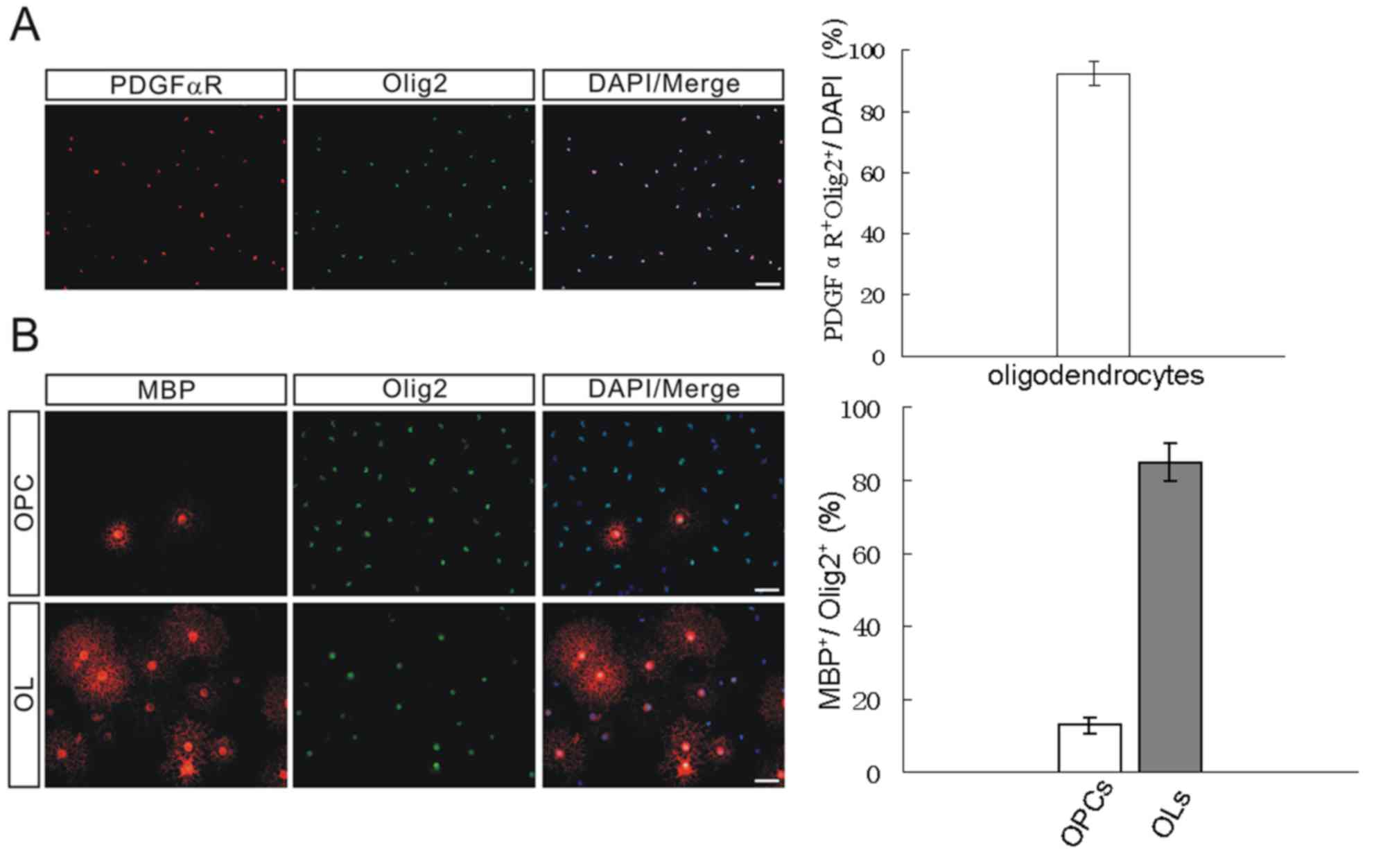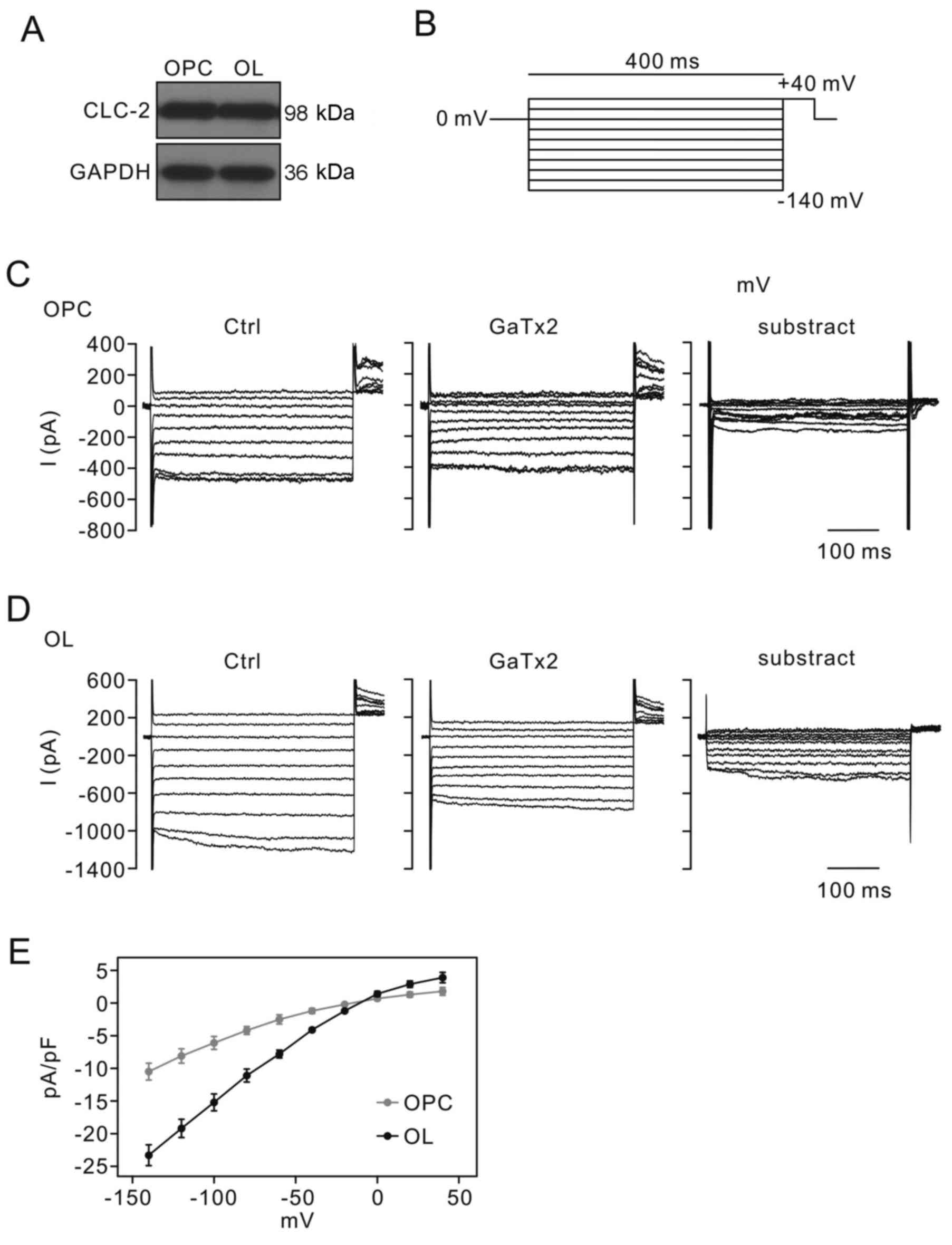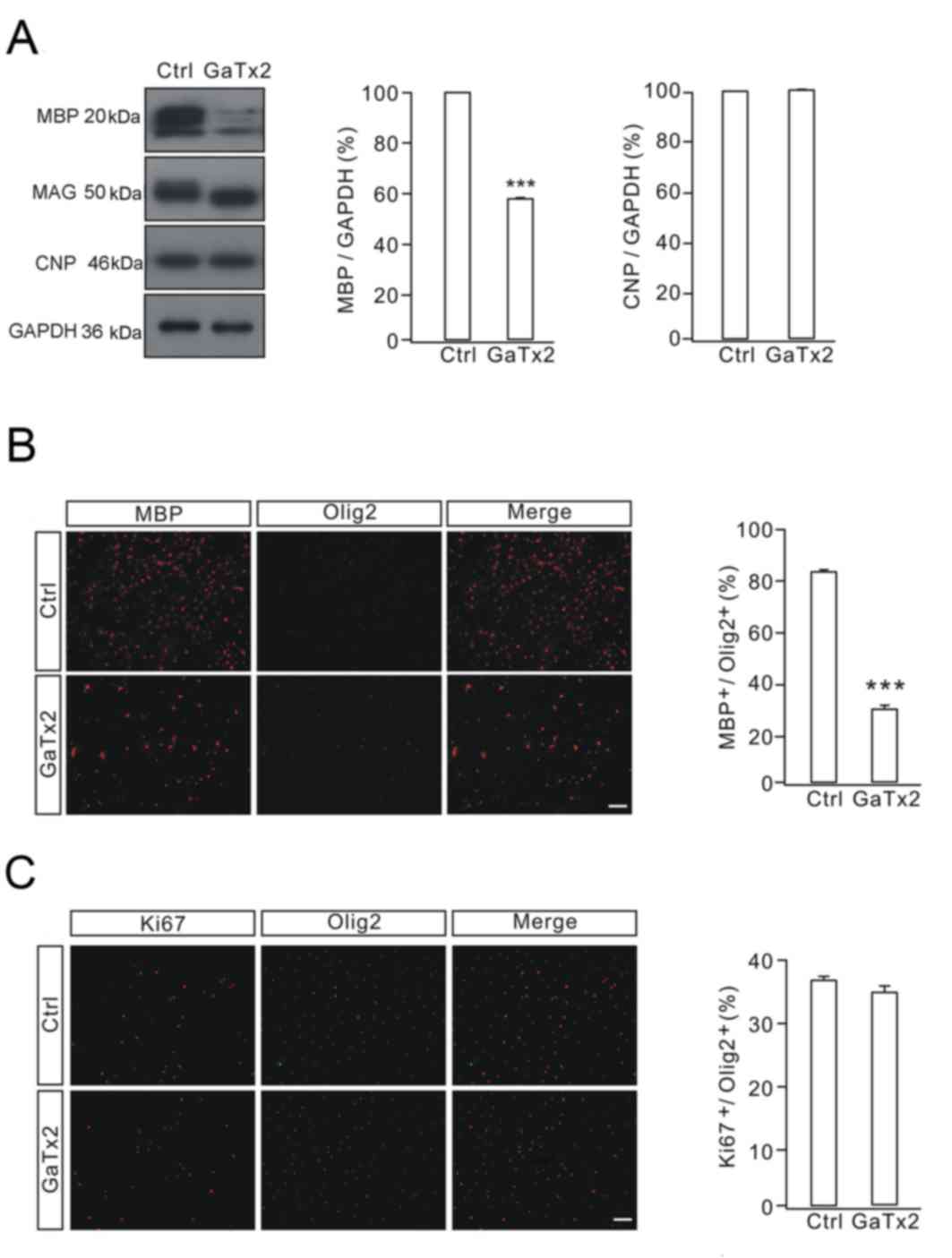|
1
|
Tauheed AM, Ayo JO and Kawu MU: Regulation
of oligodendrocyte differentiation: Insights and approaches for the
management of neurodegenerative disease. Pathophysiology.
23:203–210. 2016. View Article : Google Scholar : PubMed/NCBI
|
|
2
|
Mi S, Lee X, Hu Y, Ji B, Shao Z, Yang W,
Huang G, Walus L, Rhodes K, Gong BJ, et al: Death receptor 6
negatively regulates oligodendrocyte survival, maturation and
myelinatin. Nat Med. 17:816–821. 2011. View
Article : Google Scholar : PubMed/NCBI
|
|
3
|
Wolswijk G: Oligodendrocyte survival, loss
and birth in lesions of chronic-stage multiple sclerosis. Brain.
123:105–115. 2000. View Article : Google Scholar : PubMed/NCBI
|
|
4
|
Billiards SS, Haynes RL, Folkerth RD,
Borenstein NS, Trachtenberg FL, Rowitch DH, Ligon KL, Volpe JJ and
Kinney HC: Myelin abnormalities without oligodendrocyte loss in
periventricular leukomalacia. Brain Pathol. 18:153–163. 2008.
View Article : Google Scholar : PubMed/NCBI
|
|
5
|
Boespflug-Tanguy O, Labauge P, Fogli A and
Vaurs-Barriere C: Genes involved in leukodystrophies: A glance at
glial functions. Curr Neurol Neurosci Rep. 8:217–229. 2008.
View Article : Google Scholar : PubMed/NCBI
|
|
6
|
Miller RH: Regulation of oligodendrocyte
development in the vertebrate CNS. Prog Neurobiol. 67:451–467.
2002. View Article : Google Scholar : PubMed/NCBI
|
|
7
|
Emery B: Regulation of oligodendrocyte
differentiation and myelination. Science. 330:779–782. 2010.
View Article : Google Scholar : PubMed/NCBI
|
|
8
|
Wang S, Sdrulla AD, DiSibio G, Bush G,
Nofziger D, Hicks C, Weinmaster G and Barres BA: Notch receptor
activation inhibits oligodendrocyte differentiation. Neuron.
21:63–75. 1998. View Article : Google Scholar : PubMed/NCBI
|
|
9
|
Charles P, Hernandez MP, Stankoff B,
Aigrot MS, Colin C, Rougon G, Zalc B and Lubetzki C: Negative
regulation of central nervous system myelination by
polysialylated-neural cell adhesion molecule. Proc Natl Acad Sci
USA. 97:pp. 7585–7590. 2000; View Article : Google Scholar : PubMed/NCBI
|
|
10
|
Mi S, Miller RH, Lee X, Scott ML,
Shulag-Morskaya S, Shao Z, Chang J, Thill G, Levesque M, Zhang M,
et al: LINGO-1 negatively regulates myelination by
oligodendrocytes. Nat Neurosci. 8:745–751. 2005. View Article : Google Scholar : PubMed/NCBI
|
|
11
|
Arnett HA, Fancy SP, Alberta JA, Zhao C,
Plant SR, Kaing S, Raine CS, Rowitch DH, Franklin RJ and Stiles CD:
bHLH transcription factor Olig1 is required to repair demyelinated
lesions in the CNS. Science. 306:2111–2115. 2004. View Article : Google Scholar : PubMed/NCBI
|
|
12
|
Fu H, Qi Y, Tan M, Cai J, Takebayashi H,
Nakafuku M, Richardson W and Qiu M: Dual origin of spinal
oligodendrocyte progenitors and evidence for the cooperative role
of Olig2 and Nkx2.2 in the control of oligodendrocyte
differentiation. Development. 129:681–693. 2002.PubMed/NCBI
|
|
13
|
Emery B, Agalliu D, Cahoy JD, Watkins TA,
Dugas JC, Mulinyawe SB, Ibrahim A, Ligon KL, Rowitch DH and Barres
BA: Myelin gene regulatory factor is a critical transcriptional
regulator required for CNS myelination. Cell. 138:172–185. 2009.
View Article : Google Scholar : PubMed/NCBI
|
|
14
|
Liu Z, Hu X, Cai J, Liu B, Peng X, Wegner
M and Qiu M: Induction of oligodendrocyte differentiation by Olig2
and Sox10: Evidence for reciprocal interactions and
dosage-dependent mechanisms. Dev Biol. 302:683–693. 2007.
View Article : Google Scholar : PubMed/NCBI
|
|
15
|
He Y, Dupree J, Wang J, Sandoval J, Li J,
Liu H, Shi Y, Nave KA and Casaccia-Bonnefil P: The transcription
factor Yin Yang 1 is essential for oligodendrocyte progenitor
differentiation. Neuron. 55:217–230. 2007. View Article : Google Scholar : PubMed/NCBI
|
|
16
|
Wegner M: A matter of identity:
Transcriptional control in oligodendrocytes. J Mol Neurosci.
35:3–12. 2008. View Article : Google Scholar : PubMed/NCBI
|
|
17
|
Fancy SP, Baranzini SE, Zhao C, Yuk DI,
Irvine KA, Kaing S, Sanai N, Franklin RJ and Rowitch DH:
Dysregulation of the Wnt pathway inhibits timely myelination and
remyelination in the mammalian CNS. Genes Dev. 23:1571–1585. 2009.
View Article : Google Scholar : PubMed/NCBI
|
|
18
|
Zhou L, Shao CY, Xu SM, Ma J, Xie YJ, Zhou
L, Teng P, Wang Y, Qiu M and Shen Y: GSK3β promotes the
differentiation of oligodendrocyte precursor cells via
β-catenin-mediated transcriptional regulation. Mol Neurobiol.
50:507–519. 2014. View Article : Google Scholar : PubMed/NCBI
|
|
19
|
Williamson AV, Compston DA and Randall AD:
Analysis of the ion channel complement of the rat oligodendrocyte
progenitor in a commonly studied in vitro preparation. Eur J
Neurosci. 9:706–720. 1997. View Article : Google Scholar : PubMed/NCBI
|
|
20
|
Kraus V, Srivastava R, Kalluri SR, Seidel
U, Schuelke M, Schimmel M, Rostasy K, Leiz S, Hosie S, Grummel V
and Hemmer B: Potassium channel KIR4.1-specific antibodies in
children with acquired demyelinating CNS disease. Neurology.
82:470–473. 2014. View Article : Google Scholar : PubMed/NCBI
|
|
21
|
Srivastava R, Aslam M, Kalluri SR,
Schirmer L, Buck D, Tackenberg B, Rothhammer V, Chan A, Gold R,
Berthele A, et al: Potassium channel KIR4.1 as an immune target in
multiple sclerosis. N Engl J Med. 367:115–123. 2012. View Article : Google Scholar : PubMed/NCBI
|
|
22
|
Kirischuk S, Scherer J, Möller T,
Verkhratsky A and Kettenmann H: Subcellular heterogeneity of
voltage-gated Ca2+ channels in cells of the oligodendrocyte
lineage. Glia. 13:1–12. 1995. View Article : Google Scholar : PubMed/NCBI
|
|
23
|
Zhao B, Quan H, Ma T, Tian Y, Cai Q and Li
H: 4,4′-Diisothiocyanostilbene-2,2′-disulfonic acid (DIDS)
ameliorates ischemia-hypoxia-induced white matter damage in
neonatal rats through inhibition of the voltage-gated chloride
channel ClC-2. Int J Mol Sci. 16:10457–10469. 2015. View Article : Google Scholar : PubMed/NCBI
|
|
24
|
Yang Z, Watanabe M and Nishiyama A:
Optimization of oligodendrocyte progenitor cell culture method for
enhanced survival. J Neurosci Methods. 149:50–56. 2005. View Article : Google Scholar : PubMed/NCBI
|
|
25
|
Wang Z, Wang YN, Sun CL, Yang D, Su LD,
Xie YJ, Zhou L, Wang Y and Shen Y: C-terminal domain of ICA69
interacts with PICK1 and acts on trafficking of PICK1-PKCα complex
and cerebellar plasticity. PLoS One. 8:e838622013. View Article : Google Scholar : PubMed/NCBI
|
|
26
|
Lalor PA, Mapp PI, Hall PA and Revell PA:
Proliferative activity of cells in the synovium as demonstrated by
a monoclonal antibody, Ki67. Rheumatol Int. 7:183–186. 1987.
View Article : Google Scholar : PubMed/NCBI
|
|
27
|
Thiemann A, Gründer S, Pusch M and Jentsch
TJ: A chloride channel widely expressed in epithelial and
non-epithelial cells. Nature. 356:57–60. 1992. View Article : Google Scholar : PubMed/NCBI
|
|
28
|
Sík A, Smith RL and Freund TF:
Distribution of chloride channel-2-immunoreactive neuronal and
astrocytic processes in the hippocampus. Neuroscience. 101:51–65.
2000. View Article : Google Scholar : PubMed/NCBI
|
|
29
|
Weng Q, Chen Y, Wang H, Xu X, Yang B, He
Q, Shou W, Chen Y, Higashi Y, Van den Berghe V, et al: Dual-mode
modulation of Smad signaling by Smad-interacting protein Sip1 is
required for myelination in the central nervous system. Neuron.
73:713–728. 2012. View Article : Google Scholar : PubMed/NCBI
|
|
30
|
Jentsch TJ, Stein V, Weinreich F and
Zdebik AA: Molecular structure and physiological function of
chloride channels. Physiol Rev. 82:503–568. 2002. View Article : Google Scholar : PubMed/NCBI
|
|
31
|
Olsen ML, Schade S, Lyons SA, Amaral MD
and Sontheimer H: Expression of voltage-gated chloride channels in
human glioma cells. J Neurosci. 23:5572–5582. 2003.PubMed/NCBI
|
|
32
|
Levison SW, Chuang C, Abramson BJ and
Goldman JE: The migrational patterns and developmental fates of
glial precursors in the rat subventricular zone are temporally
regulated. Development. 119:611–622. 1993.PubMed/NCBI
|
|
33
|
Amberger VR, Avellana-Adalid V, Hensel T,
Baron-Van Evercooren A and Schwab ME: Oligodendrocyte-type 2
astrocyte progenitors use ametalloendoprotease to spread and
migrate on CNS myelin. Eur J Neurosci. 9:151–162. 1997. View Article : Google Scholar : PubMed/NCBI
|
|
34
|
Huang H, Zhao XF, Zheng K and Qiu M:
Regulation of the timing of oligodendrocyte differentiation:
Mechanisms and perspectives. Neurosci Bull. 29:155–164. 2013.
View Article : Google Scholar : PubMed/NCBI
|
|
35
|
Blanz J, Schweizer M, Auberson M, Maier H,
Muenscher A, Hübner CA and Jentsch TJ: Leukoencephalopathy upon
disruption of the chloride channel ClC-2. J Neurosci. 27:6581–6589.
2007. View Article : Google Scholar : PubMed/NCBI
|
|
36
|
He F, Peng Y, Yang Z, Ge Z, Tian Y, Ma T
and Li H: Activated ClC-2 inhibits p-Akt to repress myelination in
GDM newborn rats. Int J Biol Sci. 13:179–188. 2017. View Article : Google Scholar : PubMed/NCBI
|
|
37
|
Guo R, Pan F, Tian Y, Li H, Li S and Cao
C: Down-regulation of ClC-3 expression reduces epidermal stem cell
migration by inhibiting volume-activated chloride currents. J Membr
Biol. 249:281–292. 2016. View Article : Google Scholar : PubMed/NCBI
|
|
38
|
Klaus F, Laufer J, Czarkowski K,
Strutz-Seebohm N, Seebohm G and Lang F: PIKfyve-dependent
regulation of the Cl-channel ClC-2. Biochem Biophys Res Commun.
381:407–411. 2009. View Article : Google Scholar : PubMed/NCBI
|
|
39
|
Palmada M, Dieter M, Boehmer C, Waldegger
S and Lang F: Serum and glucocorticoid inducible kinases
functionally regulate ClC-2 channels. Biochem Biophys Res Commun.
321:1001–1006. 2004. View Article : Google Scholar : PubMed/NCBI
|
|
40
|
Makara JK, Rappert A, Matthias K,
Steinhäuser C, Spät A and Kettenmann H: Astrocytes from mouse brain
slices express ClC-2-mediated Cl-currents regulated during
development and after injury. Mol Cell Neurosci. 23:521–530. 2003.
View Article : Google Scholar : PubMed/NCBI
|
|
41
|
Földy C, Lee SH, Morgan RJ and Soltesz I:
Regulation of fast-spiking basket cell synapses by the chloride
channel ClC-2. Nat Neurosci. 13:1047–1049. 2010. View Article : Google Scholar : PubMed/NCBI
|














